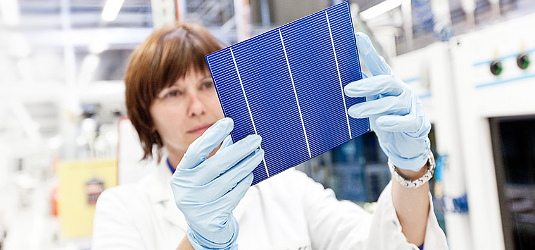Verified by Fraunhofer ISE CalLab, the rating of 19.5% efficiency for a standard module of 1,670 x 1,000 mm2 sets a new world record for multicrystalline panels; Hanwha achieved the result using its Q.ANTUM cells with four busbars.
Korean solar module producer Hanwha Q Cells has raised the bar for multicrystalline module efficiencies, confirming this week that a standard 300-watt prototype has delivered 19.5% conversion efficiency.
The world-record is based on a prototype module made with high-efficiency multicrystalline Q.AMTUM solar cells with four busbars, and was produced at the firm’s Center for Technology Innovation and Quality in Thalheim, Germany.
Despite being a prototype module at this stage, the pilot line replicated the exact production processes required to mass-produce the module. The results were independently verified by Germany’s Fraunhofer ISE CalLab, which confirmed the 19.5% efficiency in relation to the aperture area (of 1,670 x 1,000 mm2) and a power output of 301W using 60 cells.
“The industry has been trying hard to push the efficiency and power of multicrystalline solar cells and modules,” said Hanwha Q Cells’ director of R&D Jörg Müller. “We have been extremely confident that the know-how and experience from inventing, developing and commercializing Q.ANTUM technology would give us the decisive competitive edge. Now we are very proud to be the first PV company to present a 19.5% solar module efficiency based on multicrystalline cells. Up until now, such values were only reached using monocrystalline silicon and complex processing.”
Daniel Jeong, Head of Global R&D at Hanwha Q CELLS added: “Hanwha Q CELLS produces Q.ANTUM-based high efficiency products in large scales in our state of the art international production facilities with a production track record of over 1.5 GW since 2012.” He also added:”The new world-record prototype clearly points the way, as to where Q.ANTUM can bring performance and efficiency of commercial multicrystalline PV modules in the near future.”
This content is protected by copyright and may not be reused. If you want to cooperate with us and would like to reuse some of our content, please contact: editors@pv-magazine.com.








By submitting this form you agree to pv magazine using your data for the purposes of publishing your comment.
Your personal data will only be disclosed or otherwise transmitted to third parties for the purposes of spam filtering or if this is necessary for technical maintenance of the website. Any other transfer to third parties will not take place unless this is justified on the basis of applicable data protection regulations or if pv magazine is legally obliged to do so.
You may revoke this consent at any time with effect for the future, in which case your personal data will be deleted immediately. Otherwise, your data will be deleted if pv magazine has processed your request or the purpose of data storage is fulfilled.
Further information on data privacy can be found in our Data Protection Policy.